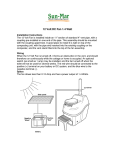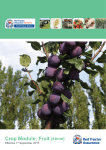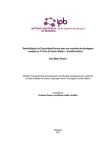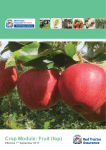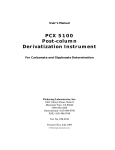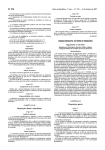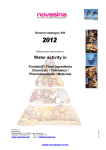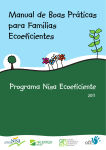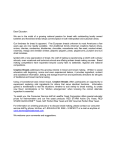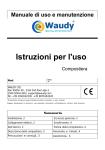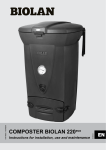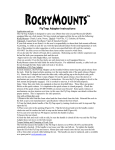Download HERE - Ekolet.com
Transcript
Place these instructions in a visible place in your toilet Model: VS Instruction 2012-1-1 How to Use the Ekolet Composting Toilet Always close the toilet lid after use. Fill the composting toilet with toilet waste. You can add kitchen biological waste but they will bring banana flies (Drosophila) into the composter. If you store food waste in the kitchen, be sure to keep this waste in a covered container to keep flies away. If flies become a problem, the eggs or larvae can be destroy by pesticides that are often used in cowsheds (Dimilin for example) or pesticides used to destroy flying insects (Baygon for example). You can increase the amount of waste that can fit in any one compartment by rotating the compartment 20–30 cm, so that the sides of the compartment are also filled. When a compartment is full, cover the waste with a buckets of soil, peat or old compost. Empty the oldest compartment through the hatch on the side. Rotate the tank so that an empty compartment, with some centimetres layer of straw, chopped bark or acid peat on the bottom, can be used next. Rotate the composter in a warm season by hand grip at the edges of the hatch or by using the twist-toggle for help. Remove the fan (please refer to the "To Change the Fan" section written below) and wash it using a brush and water. The composting toilet is ready for use again. We recommend washing the filter cloth when the composting sector is emptied 2-3 times. Use a water hose, brush, and an environmentally friendly detergent. Brush always away from the hatch. The waste produced in the composting toilet is fertilizing soil that can be given to ornamental plants as such. The liquid oozing from the compost is odourless, does not attract insects, and is good (diluted with water) for watering plants after allowing a few weeks for settling. The liquid waste receptacle should be rinsed every once in a while, after the composter has been rotated a full circle, for example. Rinse the receptacle by taking down the hose located behind the sheet metal rim. Spray clean water into the hole located above this hose. (The hole is covered with a plug.) To Change the Fan: Fan An electric Ekolet fan will usually be operational for 5–10 years, so we suggest you to change it every five years. To change the fan, disconnect the electric conductors from the fan wires, take off the service opening cover plate, remove the old fan from the fan box in the ventilation pipe mounting frame, and replace it with a new fan (see picture). ). If your fan ever gets stuck because it’s dirty (which is the most common reason reason for malfunctioning), it can be removed, washed with a brush and some water and put back into place. The electric Ekolet fan 12V/4W (92 x 92 x 32 mm) is bearing-mounted and has a moisture barrier. Fans can be purchased from an Ekolet dealer or an electronics retailer. Always have a spare fan on hand! hand You can change the power and noise of the fan by changing the voltage of the adapter. We recommend keeping the fan always on because the electric consumption is minimal. If you want to put the fan off for a longer period of time you should block the sewage pipe or cover airtight the toilet seat to prevent the smell. The Ekolet composting toilet is made of recyclable materials: polyethylene plastic, hot galvanised steel, stainless steel and aluminum. Use the Ekolet composting toilet only in the way described here and in the Instructions on What to Put into the Composter. Please visit each year our home pages (www.ekolet.com) to see the possible updates of this manual. Producer: Ekolet Oy Estetie 3 FIN-00430 Helsinki Internet Home Page: E-mail: http://www.ekolet.com [email protected] Affix visibly in the kitchen One can put into the composter As a rule of the thumb, everything that has once been alive: Normal toilet waste. The peels of fruit and vegetables. Used tealeaves and coffee (tea bags and coffee filters, too). All food leftovers. If you have big individual waste (loafs of bread, cabbage etc. it is advisable to cut these into smaller pieces before putting them into the compostor) Tissue paper unless you have used these to wipe some harmful liquids with. Newspapers or paper bags you may have used as the bottom lining of your kitchen compost-container. Soil, leftovers from the garden, leaves (but these take a lot of space). All natural materials in small quantities (wool, cotton, linen, silk). Saw dust, little chunks of wood (that have not been treated), bark, turf, etc. Never put into the composter Substances that will not decay or that are poisonous No ashes or lime (the compost will become too alkaline) No problem waste (oil, petrol, solvents, paints, biocides, disinfectants, medicines and batteries). No water that contain detergents. No plastics, glass or metals. No manmade materials, plastics, rubbers or biodegradable waste bags. No cigarettes, no household dust. No big quantities of paper; never put paper with plastic or wax on it into the compostor Baby diapers. 1.1.2012 / Ekolet Troubleshooting; Ekolet-VS composting toilet TROUBLE Urine odour outside Compost odours inside No liquid coming from the liquid exhaust tube The compost to be emptied is not yet ripe There are small flies in the toilet Toilet seat is cold or there is smell from the basement The composter container rotates rigidly CAUSE AND FIXING > Peat has not been spread to all compartment bases of the composter. Spread the peat. > There is a cap directing air flow downwards on the venting pipe. Remove the cap. > The lid of the compost container is not tightly closed. Press on the lid and put some weight on the lid’s rim if necessary. > The electrical ventilator is not rotating. Clean the ventilator according to the user manual and if this does not help, replace the ventilator. > The lid of the compost container is not tightly closed. Press on the lid and put some weight on the lid’s rim if necessary. > During winter you can also put a sheet, for instance a weekly newspaper, into the compost container on the metal mesh in the middle to prevent air flow. This also prevents evaporation so you shall want to remove the barrier for summer. > Another exhaust outlet tube is open or there is no sufficient air inlet for proper ventilation. Close the exhaust tube and/or open air inlet. > If for the exceptional building these do not help, we recommend installing on the top of the ventilation pipe (outer diameter 110 mm) a Roof fan of 230 V (Radon fan). > The 50 litres of liquids have not yet formed on the liquid base of the composter. Nothing is wrong. > The soft flushing tube attached to the composter is not behind the metal rim so the liquid flows out from this , instead of the exhaust tube. Lift the flushing tube up. > The liquid cup at the beginning of the exhaust tube is not below the central opening of the composter's base. Move it to the centre. > You have used more than one compartment a year. Upon frequent use it is helpful to throw 1-2 litres of straw, chopped bark, acid peat or similar coarse easily composting material into the compost compartment during filling. > Biodegradable bags have been thrown into the composter. Do not do that. > Fruit files can easily appear in the composter together with biological kitchen waste. Fight the flies off according to the user manual. Do not put biological waste into the composter. Compose a flytrap into the toilet by filling a drinking glass with water, add a spoonful of dishwashing liquid and 2-4 spoonful’s of apple vinegar. >Seal the joint between the seat and the floor. > Use the twist-toggle for help. Grease the roller axis. Lift the container's lid.




